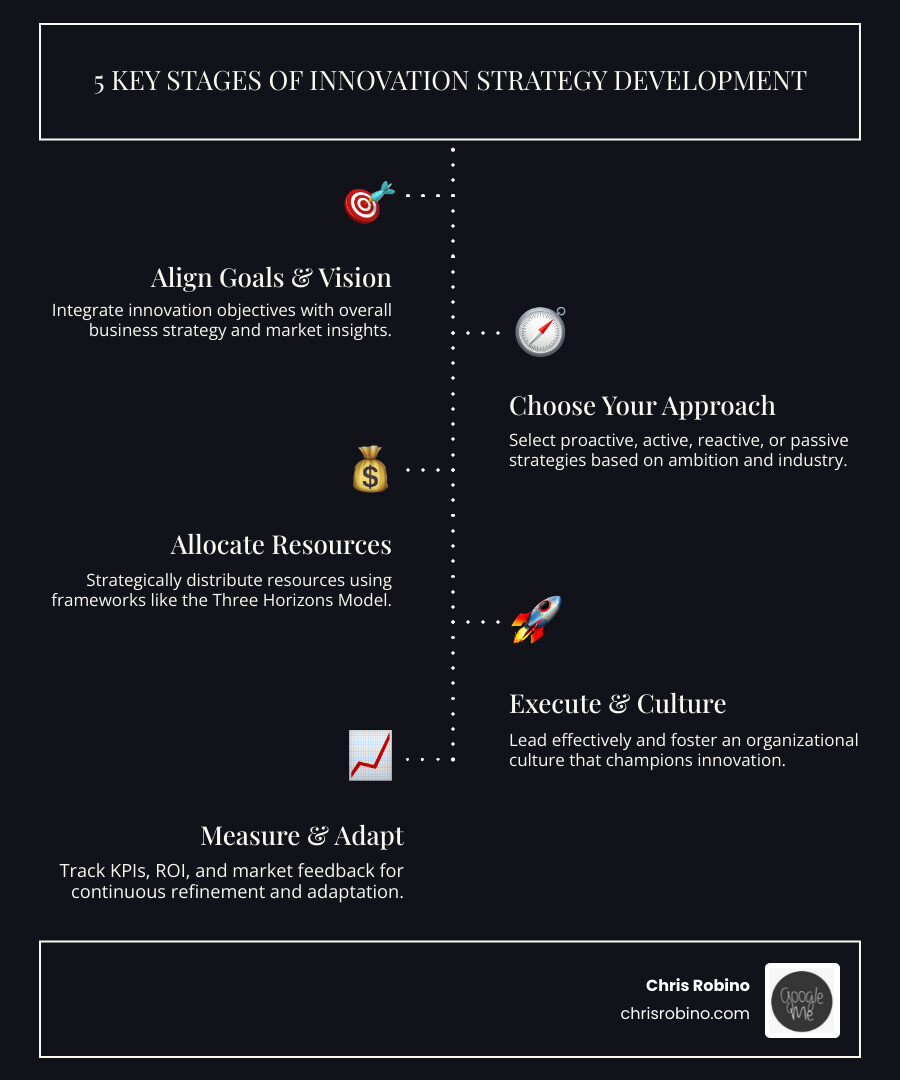Why Innovation Strategy Development Is Your Competitive Lifeline
Innovation strategy development is the structured process of building and executing capabilities that drive growth. It’s a lifeline in today’s market, yet the gap between intention and execution is staggering. While 84% of executives believe innovation is crucial for growth, only 6% are satisfied with their performance. Worse, over 50% of innovation investment is wasted on unclear strategies.
This happens when companies treat innovation as a buzzword, not a discipline. They lack a clear roadmap, strategic priorities, and the right culture. The solution is a practical, structured approach that connects business goals to specific actions and metrics. It involves:
- Aligning innovation goals with your business vision.
- Assessing your current capabilities and market position.
- Choosing the right innovation approach (e.g., proactive, reactive).
- Allocating resources strategically, often using the Three Horizons Model.
- Building a culture that supports innovation.
- Measuring KPIs and adapting your strategy.
I’m Chris Robino, and I’ve spent two decades helping organizations build digital strategies and AI-driven solutions. My approach to innovation strategy development integrates intelligent systems with business objectives to create sustainable competitive advantages.

The Core Framework for Innovation Strategy Development
Building a robust innovation strategy development plan is an ongoing journey, not a one-time task. It requires thoughtful planning, smart execution, and a willingness to adapt. Here is the framework I use to guide businesses from scattered efforts to focused competitive advantages.
Aligning Your Innovation Strategy Development with Business Vision

An innovation strategy only works when it’s deeply connected to your business vision. It should be the engine driving your company’s future, not a siloed side project. The first step is understanding your market to identify gaps and opportunities. By analyzing market research, competitor actions, and internal processes, we can spot both internal and external opportunities. Crucially, we gather feedback from customers and employees to validate ideas and ensure your strategy is dynamic and customer-centric. This approach builds on real insights, not guesswork. For companies looking to leverage cutting-edge tools, our work in AI-Driven Content Strategy shows how technology can amplify these efforts. To stay ahead, check out our Emerging Tech Insights.
Selecting the Right Innovation Approach for Your Organization
Once your vision is clear, you must choose the right innovation approach based on your goals, risk tolerance, and industry. A key choice is between open innovation and closed innovation. Closed innovation keeps R&D in-house for maximum control, while open innovation involves collaborating with external partners to access more ideas and expertise. Strategies can also be categorized by proactivity. Proactive strategies suit first-movers aiming for radical, market-creating innovations. Active strategies help businesses defend markets with continuous improvement. Reactive strategies are for “fast followers” who adopt proven innovations, and passive strategies work in slow-moving industries where waiting for market shifts is viable. For guidance on these decisions, our Digital Strategy Advice can help.
Executing the Strategy: Resources, Leadership, and Culture

A brilliant strategy fails without effective execution. This requires strong leadership, a supportive culture, and smart resource allocation. Leaders must champion new ideas, reward initiative, and foster a growth mindset. To allocate resources, I often use the Three Horizons Model. Horizon 1 focuses on the core business (typically 70% of resources), Horizon 2 explores adjacent opportunities (20%), and Horizon 3 ventures into disruptive technologies (10%). This 70-20-10 split is a flexible starting point, adjusted for your industry and ambition. This framework prevents urgent short-term needs from crowding out important long-term investments. It’s okay to Go Make Mistakes as long as you learn from them.
Overcoming Pitfalls in Your Innovation Strategy Development
Many innovation initiatives fail due to common pitfalls, with over 50% of investment wasted on unclear strategies. Key challenges include unclear expectations, where teams lack direction without defined benchmarks. Missing or redundant ownership creates chaos and wastes resources. Underfunding strangles promising ideas, especially long-term projects. Finally, a lack of central oversight leads to fragmented efforts. To avoid this, define measurable goals, establish clear project ownership, fund teams adequately, and implement governance structures to ensure all efforts align with business priorities. Understanding How Do You Lose is often the first step to winning.
Measuring Success and Adapting for the Future
Innovation requires continuous measurement and adaptation. Your strategy must evolve with the market. We establish clear Key performance indicators (KPIs) like return on investment (ROI), time to market, and product adoption rates. We also track the percentage of revenue from new innovations. Regularly monitoring these metrics, along with customer feedback and market analysis, allows us to assess performance and adapt. Leveraging tools like AI Powered Analytics provides deep insights to make data-driven decisions and keep your strategy future-proof.
Learning from Real-World Successes and Business Model Innovation
Real-world examples offer valuable lessons. Consider a historical example from the fiber-optics industry. After a market crash, one company thrived while a major competitor went bankrupt. The successful company had a robust innovation strategy driven by a clear vision and consistent R&D investment, even in tough times. The other lacked this and failed. The lesson is that a strong strategy is a lifeline. This includes business model innovation—rethinking how you create, deliver, and capture value. This is distinct from product or process innovation and involves making significant changes to how a business operates. True breakthroughs happen when you reimagine the entire system. My work with Innovation in Media Companies often involves this kind of strategic overhaul.
Conclusion: Building a Resilient Innovation Engine

In a world of constant change, a well-executed innovation strategy development plan is your business’s lifeline. We’ve covered the essentials: aligning goals with your vision, choosing the right approach, executing with strong leadership, avoiding common pitfalls, and measuring progress to adapt.
Building an innovative company is a long-term commitment, not a sprint. It requires strategic resource allocation and a culture that accepts smart risks. By systematically strengthening your innovation capabilities, you are future-proofing your business and securing a lasting competitive advantage.
At Chris Robino, we help businesses steer this complex landscape. Our expertise in emerging tech, digital strategies, and AI-driven solutions provides streamlined access to the insights that matter. Let’s work together to build a robust innovation engine that drives sustainable growth. Ready to transform your approach? Explore how our Technology Innovation Consulting Firm can make a difference.
SEO Strategies for Large Companies
Large companies face unique SEO challenges that require sophisticated, scalable approaches. With thousands of pages, multiple product lines, and diverse audiences, enterprise SEO demands strategic planning and robust execution frameworks.
Enterprise Keyword and Topic Mapping
Successful enterprise SEO starts with comprehensive keyword research that goes beyond basic volume metrics. Large companies should cluster search intents by product line and market segment, creating detailed topic maps that align with business objectives. Leverage your first-party data from customer interactions, support tickets, and internal search queries to identify content gaps. Scale long-tail keyword coverage programmatically through templated content strategies, but maintain quality standards through rigorous editorial guidelines and review processes.
Technical SEO Foundations at Scale
Technical excellence becomes critical when managing thousands of URLs. Focus on optimizing Core Web Vitals across your entire site, ensuring consistent mobile rendering and efficient JavaScript hydration. Manage crawl budget strategically through XML sitemap optimization, proper canonicalization, and robots.txt directives. For e-commerce sites, faceted navigation requires careful handling to prevent duplicate content issues while maintaining crawlability of important category combinations.
Information Architecture and Internal Linking
Build clear taxonomies that reflect user intent and business structure. Implement hub-and-spoke topic clusters that establish topical authority while distributing link equity effectively. Use breadcrumb navigation consistently, and ensure pagination is properly implemented with rel=”prev” and rel=”next” tags. Strategic internal linking should connect related content across silos, breaking down organizational barriers that often limit SEO performance.
Structured Data Implementation
Large companies should implement comprehensive schema.org markup including Product, Article, Organization, FAQ, and JobPosting schemas where relevant. Maintain consistent entity data across all digital channels to reinforce your knowledge graph presence. This structured approach helps search engines understand your content relationships and can enhance SERP visibility through rich snippets.
Local and International SEO Management
For companies with physical locations, manage store pages systematically with consistent NAP (Name, Address, Phone) data and accurate citation management. Create localized content that serves regional audiences while maintaining brand consistency. International operations require proper hreflang implementation for language and region pairs, ensuring users find the most relevant version of your content.
Scalable Content Operations
Establish editorial governance frameworks with clear content standards, reusable templates, and component libraries. Build review workflows that reinforce expertise and experience while maintaining author bylines and source transparency. This systematic approach enables content production at scale without sacrificing quality or brand voice.
Strategic Digital PR and Link Building
Earn high-quality backlinks through data-driven studies, thought leadership content, and strategic industry partnerships. Large companies have unique advantages in creating newsworthy content that naturally attracts links. Focus on building relationships with industry publications and avoid automated link schemes that could trigger penalties.
Measurement and Performance Monitoring
Unify data from Search Console, analytics platforms, and server log files to create comprehensive performance dashboards. Establish cohort-based KPIs that track different content types and user segments. Implement experimentation frameworks for testing SEO hypotheses, and set up alerting systems for traffic anomalies or ranking fluctuations.
Governance and Compliance
Define clear roles and responsibilities using RACI matrices for SEO tasks across teams. Enforce quality assurance processes that include accessibility compliance (WCAG standards) and privacy reviews. Maintain brand consistency across thousands of pages through automated checks and regular audits.
Migration and Platform Change Management
Use rigorous playbooks for website migrations and redesigns. Conduct thorough staging environment audits, create comprehensive 301 redirect mappings, and perform content parity checks. Implement pre and post-launch monitoring protocols to catch issues quickly and minimize traffic loss during transitions.
Future-Proofing Your SEO Strategy
Monitor algorithm updates and evolving SERP features to stay ahead of changes. Optimize for AI-powered search experiences by creating well-structured, comprehensive content that answers user questions thoroughly. Maintain content freshness at scale through systematic update schedules and automated monitoring for outdated information.
Large companies that excel at SEO treat it as a strategic business function, not just a marketing tactic. Success requires cross-functional collaboration, executive buy-in, and sustained investment in both technology and talent. By building robust processes and maintaining focus on user experience, enterprise organizations can achieve sustainable organic growth that drives meaningful business results.
